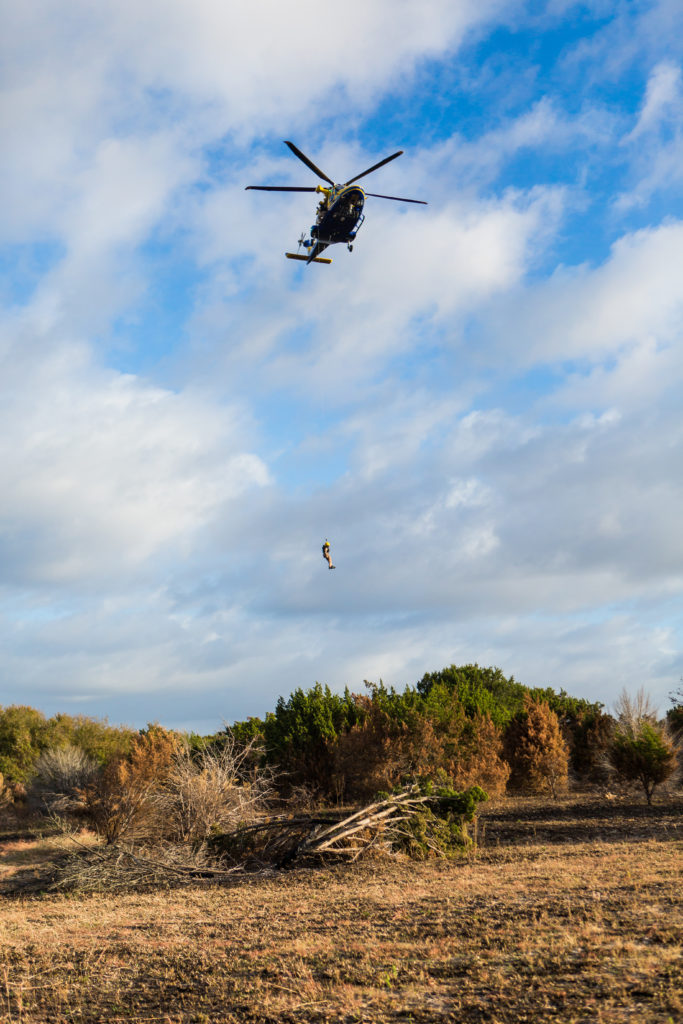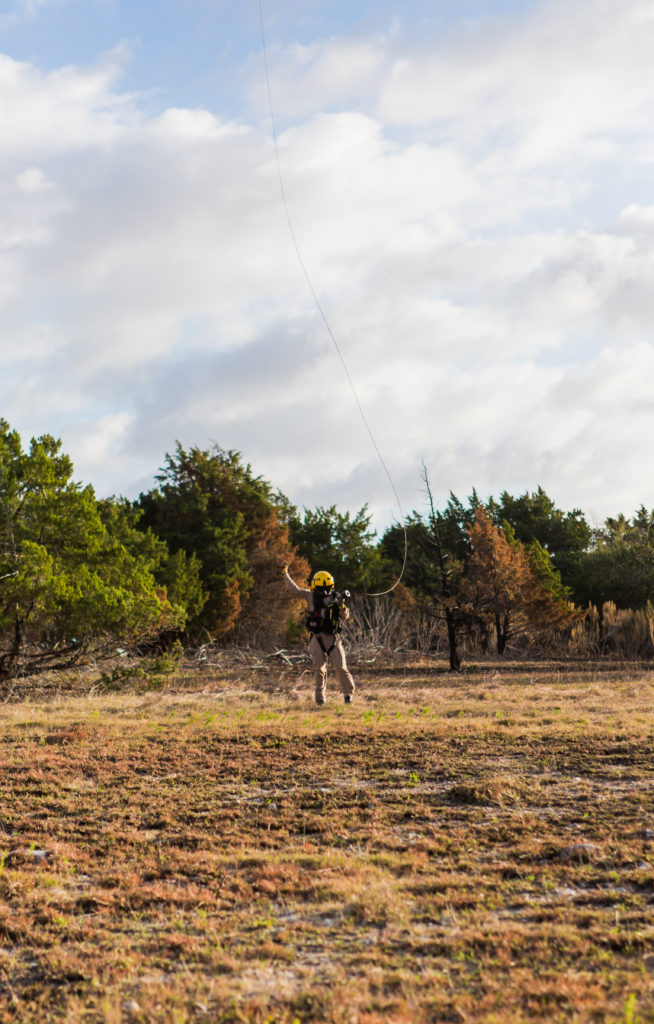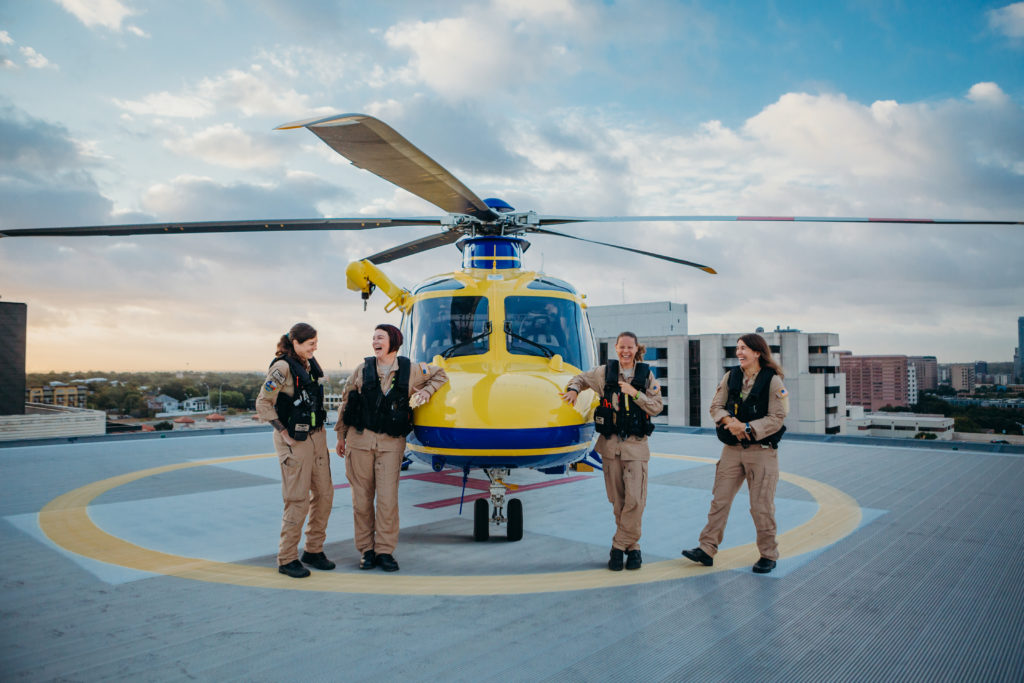As part of an elite team of emergency-rescue helicopter nurses, the women of Travis County Star Flight are everyday heroes putting their lives on the line to perform high-risk, lifesaving missions.
By Jenny Hoff, Photos by Taylor Prinsen
Travis County Star Flight is considered one of the premier emergency-rescue helicopter services in the country. It also employs more female rescue nurses than any other organization of its kind. The current team of 34 providers includes four women, a milestone for the industry. Star Flight does more than just provide critical care and quickly transport injured people to the hospital. The team performs dangerous still- and swift-water rescues, search and rescue operations, high-angle rescues, fire-suppression and aerial-reconnaissance services, and law safety assistance. For Ashley Voss-Liebig, Jennifer Roberts, Rita Sears and Holly Kareiva, it’s not just a job; it’s a personal mission.
DAY SHIFT: 7 A.M. TO 7 P.M.
It’s a gray and rainy morning. I-35 is in the throes of rush-hour traffic and the slick roads set the scene for likely accidents to come. The Star Flight hangar is bustling with activity as the pilot, medics and nurses complete a lengthy safety checklist and set out their gear. The atmosphere is both serious and playful; each crew member meticulously completes his or her checks while also engaging in some good-natured jabs with each other. It’s clear this group is more than simply a bunch of co-workers.
“We’re more like a dysfunctional family,” Ashley Voss-Liebig, Travis County Star Flight head nurse and clinical supervisor, says with a laugh. “As a crew, we have to feel very safe with our team. Even if we don’t always like each other, we love and respect each other.”
This particular morning, Voss-Liebig is with crew chief Jennifer Roberts, whose job it will be to lower other rescuers down on the hoist into whatever precarious situations they confront: floods, wildfires, accidents. While directing the hoist is slightly less hazardous than being attached to it, the task comes with more stress. Roberts must perform her duty exactly right to ensure the safety of her rescuer and patient. There is no room for error. Windy and rainy days like this one don’t make the job any easier.
“Every hoist rescue is crazy,” Roberts says. “Even though we train all the time, when you actually do it in real life, it’s always stressful.”
While rescuer fatalities are rare, this is a dangerous job that requires absolute precision. Just before Roberts and Voss-Liebig joined Star Flight, another rescue nurse, Kristin McLain, died when she fell 100 feet during a rescue mission. An NTSB investigation found no issues with any of the equipment used and determined probable cause of the accident was McLain was not properly attached to the hoist system. McLain was a seven-year veteran of Star Flight, and her loss hit the community and tight-knit crew hard. The hangar where the crew is prepping this gray morning is now named for her.
“It can be dangerous,” Roberts says. “But you have trust in the procedures and policies. If you’re always thinking, ‘What if?’ you can’t do your mission.”
Both Roberts and Voss-Liebig are no strangers to dangerous jobs. Though Voss-Liebig started her adult life as a lobbyist with aspirations to become a senator, her course changed when she joined the U.S. Army after 9/11 and completed a tour of duty in Yusufiyah, Iraq, in a region known as the Triangle of Death.
“I knew I didn’t want to hurt people, so I joined the medic unit,” she says. “I did well. It turned out I could keep my cool under pressure, run fast and obey orders. All of my comrades were coming in injured or dying, and I was able to mother all of them, look after them, and it felt like I had found my thing.”
Today, Voss-Liebig considers herself the mother hen of the Star Flight crew. She’s emotionally aware and protective of her colleagues. She spends a good deal of her working hours educating other EMS workers, teaching them how to handle stressful situations. It’s not a role she leaves at work. She’s also mother to a 12-year-old girl, Ainsleigh, who Voss-Liebig encourages to think for herself and work hard.
“She understands commitment and that she isn’t the center of the universe,” Voss-Liebig says. “She understands Mommy has a super-cool job and that I’m part of a team, and she’s proud that her mommy is one of the only women who does this.”
As a mom, Voss-Liebig admits some of the rescues she’s had to perform on children were especially hard.
“Not long ago, I was called out to a rescue where a 4-year-old boy—who looked so much like my daughter at that age—was trapped under a vehicle,” she says, her eyes watering at the memory. “We knew that the likelihood of him surviving would be nil. I just remember thinking that we were playing God, trying to resuscitate this child that didn’t have a chance. Was that the right thing to do?”
The child died at the hospital, where his family had to make the decision to remove life support. Weeks later, Voss-Liebig spoke to the family, and she came out of that conversation feeling much better. The family had been grateful they could at least donate their son’s organs.
“In every single one of these emergencies, these are people,” Voss-Liebig says. “Each person is someone’s someone, and you can’t fix it for them all the time. We’re fixers; we want to fix everything and we don’t always get to.”
“We’re fixers; we want to fix everything and we don’t always get to.”
ASHLEY VOSS-LIEBIG
After every rescue, the team conducts a debriefing meeting to discuss how they could have done better, how they could have moved faster and how they could have shaved seconds off their response time.
“After a difficult rescue or high-stress situation, it takes a toll,” Roberts says. “I’m mentally replaying my actions and always asking myself, ‘What could I have done better?’ I’m trying to find the smallest lesson and improvements for next time.”
Despite such constant and uncomfortable questioning, Roberts knew at a young age she was meant to rescue people. As a teenager working as a ski patroller in Maine, she witnessed a helicopter rescue that changed her career plan from doctor to rescue nurse.
She went on to study nursing at the University of Utah and worked in hospital emergency rooms for five years before taking to the skies with a flight program in Phoenix, where she stayed for nine years. Star Flight was the pinnacle, however, and she was thrilled when she made it to the team in 2015, joining at the same time as Voss-Liebig.
The application and training program for Star Flight is rigorous, with an intense physical- fitness test and in-person interviews for only the best of the best. Applicants must demonstrate a dedication not only to extreme teamwork, but also a commitment to the time-consuming lifestyle.
With three 12-hour days of work a week (7 a.m. to 7 p.m., followed by 10 a.m. to 10 p.m. and then 7 p.m. to 7 a.m.), downtime is usually spent recuperating and getting back to a normal sleep schedule. Since Star Flight is funded by the government (as opposed to most flight-rescue teams in the country, which are for-profit), its Dell Children’s Star Flight helicopter operates 24/7, meaning the small team is always prepared to come in at the last minute if a crewmate gets sick. Roberts admits it can put added pressure on personal life.
“If I get called in on a day off or when my shift is over, my girlfriend will sometimes ask, ‘Why you? Why does it have to be you?’ ” she says. “I have to remind her that I signed up for this. I was asked in my job interview how I could commit and I said, ‘I’m all in.’ “
As crew chief, Roberts is often in charge of hoist rescues, which are used when a situation is so critical ground EMS can’t reach a patient in time or the victim is in a place an ambulance can’t get to. Roberts lowers a rescue nurse, who is attached with a carabiner to a cord, into the scene.
“In my first rescue, I lowered our nurse into the Greenbelt, where someone had fallen about 40 feet,” she says. “He then detached himself, got the patient, did stabilizing procedures and packed them to then hoist out. Once I lifted them, we got to the hospital in less than two minutes.”
While the work is stressful, Roberts says she couldn’t imagine doing anything else. The ability to help people in some of the most critical situations offers her a different perspective on life.
“It shows you how fragile life is,” she says. “You really can’t take anything for granted. I’m just grateful and thankful for what I have.”
NIGHT SHIFT: 7 P.M. TO 7 A.M.
When crew chief Rita Sears and Holly Kareiva, the newest nurse on the Star Flight team, show up for work, the sun has already set behind the Star Flight helicopter, this one parked on the roof of Dell Children’s Medical Center. Travis County Star Flight helicopters are unique in that they’re the only of their kind used by a rescue team in the United States. Made in Italy and costing more than $8 million each, the AW169s are too expensive for private rescue services to buy. They are decked out with top-of-the-line safety features, making them the ideal rescue vehicles for Travis County Star Flight. Unlike Star Flight’s previous helicopters, they have two engines and are fully automated to land themselves if necessary.
Sears is a one-woman rescue machine, described by her colleagues as “incredibly strong.” It’s no wonder. She’s not only a certified nurse practitioner, paramedic and rescue nurse; she’s also a trained firefighter. Why?
“So I can fight fires,” she says, confused by the absurdity of the question.
Like Voss-Liebig, Roberts and Kareiva, she has many years of hospital-emergency-room nursing experience and flight-nurse expertise from previous jobs. While she isn’t fazed by much, she admits some rescues are tougher than others.
“In my first swift-water rescue, I was lowered down to get a man who was clinging to a tree with water up to his chest,” Sears recalls. “Only when I hit the roof did I see he was standing on his car. That’s how high the water was. We safely removed him, but when I got home, it really hit me how dangerous that situation was for me too.”
But it’s not always the most dangerous rescues that are the most jarring.
“Attempted suicides are rough,” Sears says, “because you get them, but you know, in the end, their suicide will be successful. But you think, ‘If I can get them to the hospital, their family can make a decision to donate their organs.’ So, sometimes you have to look for the silver lining.”
It can be a heavy load to bring home. With a fiance in the military, Sears says she prefers to hike and exercise on her days off, to feel the calm of nature to balance the intensity of work.
The schedules can be intense too. With four weekends on the job followed by four weekends off, it can be tough to maintain relationships. Kareiva says her last relationship ended partially because her partner couldn’t handle her schedule. Her current boyfriend is more understanding.
“We just make big plans on the weekends we have together to make up for the ones we’re apart,” Kareiva says.
Sometimes that means booking a flight for a getaway the day before, only once she is certain she won’t be called into work. But the emotional toll, late nights and danger are all worth it, she says, because she gets to experience her purpose every day.
“I was involved in a rescue where this guy was in a tree on the side of the cliff,” she says. “After I rescued him, I thought, ‘I’ve been a nurse for nine years, but today, I actually saved a guy’s life.’ I just wanted to do it again and again so I can keep getting better.”
With four brothers, Kareiva says she feels at home working with mostly men in the male-dominated field she’s chosen. But, she admits, in the beginning, it was a bit daunting.
“My first rescue, when I hoisted in, I was going over all the steps in my head,” she says. “When I got down there, there were 20 big, burly firefighters I had to tell what to do. Afterwards, I thought, ‘On my next rescue, I need to exude more confidence to manage the situation.’ ”
What Kareiva and Sears say they do bring a little more of to rescue missions is communication, which comes less from their being female and more from their backgrounds in hospital work, they say.
“I think we see the families more,” Sears says. “We’ll go over and introduce ourselves and explain what’s happening. I like to think we bring a gentler touch to the situation.”
A CONVERSATION WITH THE LIFESAVING LADIES OF TRAVIS COUNTY STAR FLIGHT
Austin Woman: What is it like working mostly with men, especially during 12-hour shifts? What is the dynamic like?
Ashley Voss-Liebig: “The guys that we work with here are just awesome. We are 100 percent equal, respected and loved. They have gone out of their way to make sure we are successful. Several of them are older than us. It’s like having these big brothers who are constantly looking out to make sure you’re good. We all bring something different. I’m soft like a mama bird. Jen will get on their butts if something needs to happen. I think it’s good for them.”
AW: What is absolutely necessary to work in the emergency-rescue/medical field?
Jennifer Roberts: “Confidence in yourself is what we all have in common. I’m not as strong as Rita or as fast as Holly, but we all have confidence in our own capabilities.”
AW: On the job, is there a constant adrenaline rush or is there a lot of downtime?
Holly Kareiva: “Some days are super busy and some days, you don’t go out at all. I walk in the door and I never know what’s going to happen. I like the organized chaos of it all.”
AW: What do you like most about your job?
Rita Sears: “I really feel like I make a difference in somebody’s day. I feel that, because of me, someone’s day is not as bad as it could have been.”







